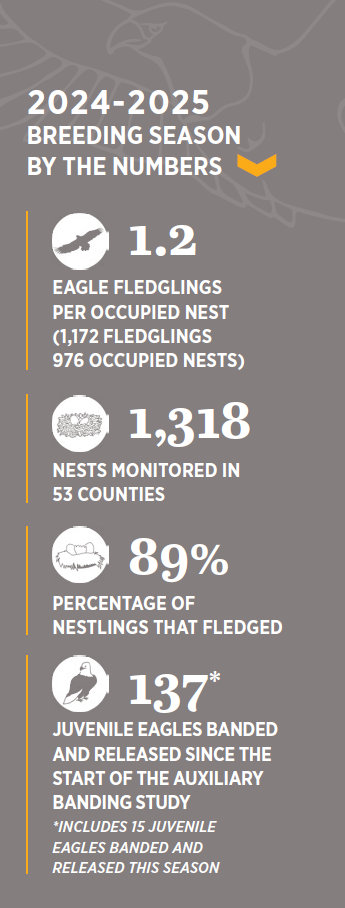
La página que intenta visitar sólo está disponible en inglés. ¡Disculpa!
The page you are about to visit is currently only available in English. Sorry!

Each EagleWatch season brings new stories of resilience—both for Florida’s Bald Eagles and for the dedicated community that monitors them. This year was no exception.
monitors them. This year was no exception.
We faced significant challenges: Highly Pathogenic Avian Influenza (HPAI) returned to Florida’s eagle population, hurricanes at the start of the 2024-2025 season battered nests along Florida’s West Coast and Panhandle, and federal take permits for general disturbances became available (read more about the permits below). Unfortunately, Florida led the nation with 158 permits issued—far more than any other state. Against this backdrop, our data reflected lower productivity and fledge rates, though the average brood size (number of fledglings produced per successful nest) has remained steady.
Amid these challenges, we celebrate important wins. EagleWatch launched its first-ever telemetry study, tracking two juveniles whose journeys took one bird all the way to Canada and another to New York. We also continued our auxiliary banding study, banding and releasing 15 juveniles this season for a total of 137 since 2017.
None of this work would be possible without the extraordinary dedication of our volunteers and supporters. This year, 770 volunteers and partners contributed 13,538 hours in the field, submitting 25,739 nest observations. Thanks to you, EagleWatch continues to be one of the most comprehensive Bald Eagle monitoring programs in the nation and a powerful voice for
protecting these iconic birds.
Together, we are making a difference for Florida’s eagles—and for future generations who will look to the sky with the same wonder we feel behind our binoculars.
In 2024, the U.S. Fish and Wildlife Service (USFWS) instituted a new General Bald Eagle Nest Disturbance and Nest Take Permit process. With a term of one year or less, these general permits allow for disturbance during the nesting season or nest removal for a list of approved activities or purposes. Applicants apply online, self-identify that they meet the qualifying criteria, and receive automatic approval for the permit without USFWS review.
Since inception, more than 500 general permits have been issued across 45 states. Florida leads with 158 general permits, far ahead of the next highest state, Washington, with 31. By contrast, 34 states have received 10 or fewer general permits.
In addition to the new general permits, USFWS continues to offer Specific Permits for Disturbance or Nest Take for projects
that don’t qualify for a general permit. All specific permits are reviewed by USFWS staff before approval. EagleWatch does
not have access to a complete list of specific permits, but is currently aware of 143 active specific permits in Florida.
While Bald Eagle populations have recovered to the point that they are no longer considered endangered or threatened, these general permits represent a big change, and the number of permits issued in Florida this first year has been significant. Over the next few seasons, EagleWatch’s statewide nest monitoring program will provide important insight into productivity trends in this new regulatory landscape, to help evaluate whether this rate of permitted “take” is sustainable.
This story originally appeared in the 2024-25 EagleWatch Annual Report.

The Audubon Center for Birds of Prey and the Avian Research and Conservation Institute are embarking on a study to better understand Bald Eagle migration and habitat use.

We spoke with a veteran EagleWatcher and a brand-new volunteer to learn more about what it's like to monitor nests,

EagleWatch volunteers are often the first ones to notice when an eaglet has fallen out of its nest, and thanks to the programs wide network, we are also able to find foster nests when the need arises.